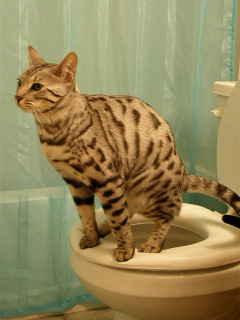Just how do you actually feel in regards to Don’t flush cat feces down the toilet?

Intro
As feline proprietors, it's necessary to bear in mind just how we deal with our feline good friends' waste. While it might seem hassle-free to flush feline poop down the bathroom, this method can have damaging repercussions for both the environment and human health.
Environmental Impact
Flushing cat poop introduces unsafe microorganisms and bloodsuckers right into the water, presenting a considerable risk to marine ecological communities. These impurities can adversely impact aquatic life and compromise water quality.
Wellness Risks
Along with ecological problems, purging feline waste can also pose wellness dangers to people. Feline feces may include Toxoplasma gondii, a bloodsucker that can cause toxoplasmosis-- a possibly serious illness, particularly for expectant women and individuals with weakened body immune systems.
Alternatives to Flushing
The good news is, there are more secure and a lot more accountable methods to deal with cat poop. Take into consideration the complying with choices:
1. Scoop and Dispose in Trash
One of the most typical method of dealing with cat poop is to scoop it right into a biodegradable bag and throw it in the garbage. Make certain to use a specialized litter inside story and throw away the waste without delay.
2. Use Biodegradable Litter
Opt for naturally degradable feline clutter made from products such as corn or wheat. These clutters are eco-friendly and can be securely taken care of in the garbage.
3. Bury in the Yard
If you have a yard, think about hiding pet cat waste in a designated location far from veggie gardens and water resources. Be sure to dig deep adequate to prevent contamination of groundwater.
4. Set Up a Pet Waste Disposal System
Purchase a pet dog garbage disposal system particularly developed for pet cat waste. These systems utilize enzymes to break down the waste, reducing smell and environmental impact.
Conclusion
Accountable pet ownership expands beyond supplying food and sanctuary-- it additionally includes correct waste monitoring. By avoiding purging cat poop down the toilet and choosing alternate disposal approaches, we can reduce our ecological impact and protect human health and wellness.
Why Can’t I Flush Cat Poop?
It Spreads a Parasite
Cats are frequently infected with a parasite called toxoplasma gondii. The parasite causes an infection called toxoplasmosis. It is usually harmless to cats. The parasite only uses cat poop as a host for its eggs. Otherwise, the cat’s immune system usually keeps the infection at low enough levels to maintain its own health. But it does not stop the develop of eggs. These eggs are tiny and surprisingly tough. They may survive for a year before they begin to grow. But that’s the problem.
Our wastewater system is not designed to deal with toxoplasmosis eggs. Instead, most eggs will flush from your toilet into sewers and wastewater management plants. After the sewage is treated for many other harmful things in it, it is typically released into local rivers, lakes, or oceans. Here, the toxoplasmosis eggs can find new hosts, including starfish, crabs, otters, and many other wildlife. For many, this is a significant risk to their health. Toxoplasmosis can also end up infecting water sources that are important for agriculture, which means our deer, pigs, and sheep can get infected too.
Is There Risk to Humans?
There can be a risk to human life from flushing cat poop down the toilet. If you do so, the parasites from your cat’s poop can end up in shellfish, game animals, or livestock. If this meat is then served raw or undercooked, the people who eat it can get sick.
In fact, according to the CDC, 40 million people in the United States are infected with toxoplasma gondii. They get it from exposure to infected seafood, or from some kind of cat poop contamination, like drinking from a stream that is contaminated or touching anything that has come into contact with cat poop. That includes just cleaning a cat litter box.
Most people who get infected with these parasites will not develop any symptoms. However, for pregnant women or for those with compromised immune systems, the parasite can cause severe health problems.
How to Handle Cat Poop
The best way to handle cat poop is actually to clean the box more often. The eggs that the parasite sheds will not become active until one to five days after the cat poops. That means that if you clean daily, you’re much less likely to come into direct contact with infectious eggs.
That said, always dispose of cat poop in the garbage and not down the toilet. Wash your hands before and after you clean the litter box, and bring the bag of poop right outside to your garbage bins.
https://trenchlesssolutionsusa.com/why-cant-i-flush-cat-poop/
Hopefully you liked our section on Can You Flush Cat Poop Down The Toilet?. Thank you for finding the time to read through our article. Loved our posting? Please share it. Help others check it out. I cherish reading our article about How to Dispose of Cat Poop and Litter Without Plastic Bags.
Book 24/7
Comments on “Reasons Flushing Cat Poop Down Your Toilet May Cause Problems - Tips for Safe Disposal”